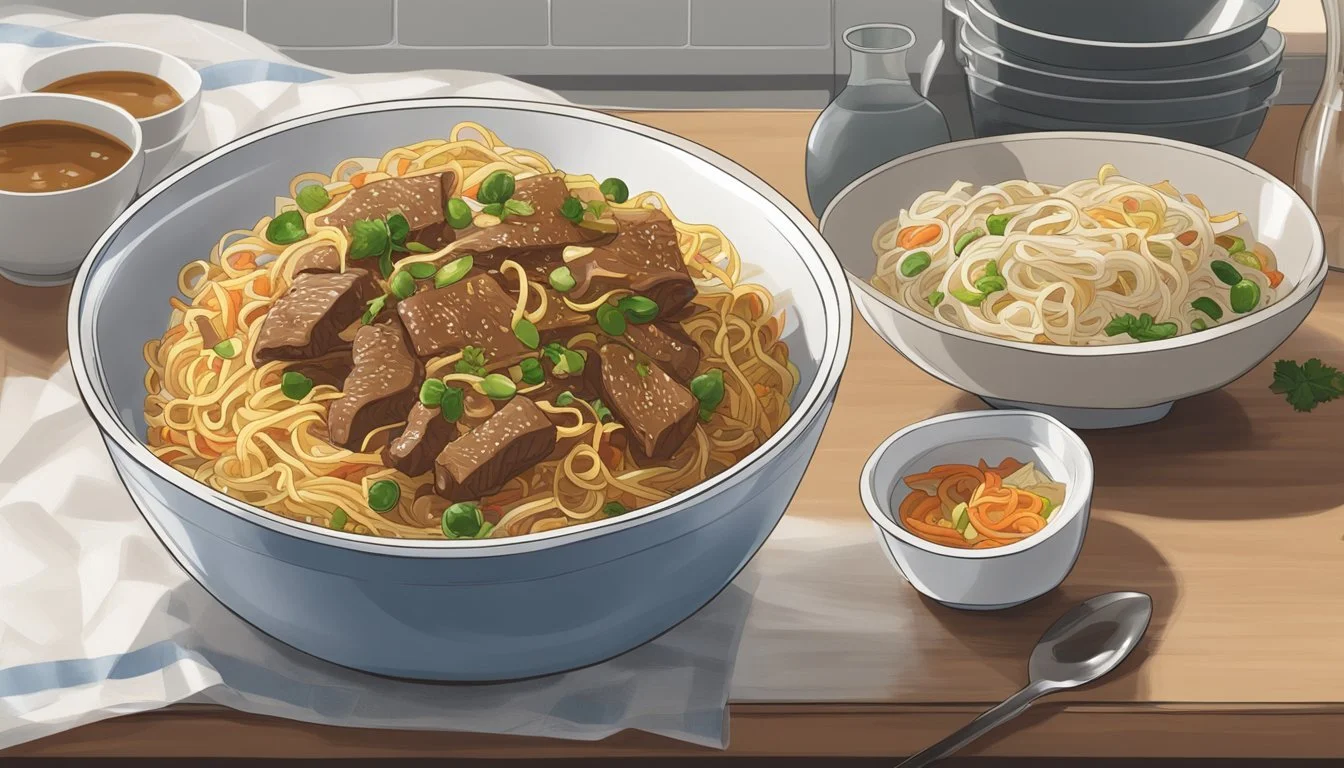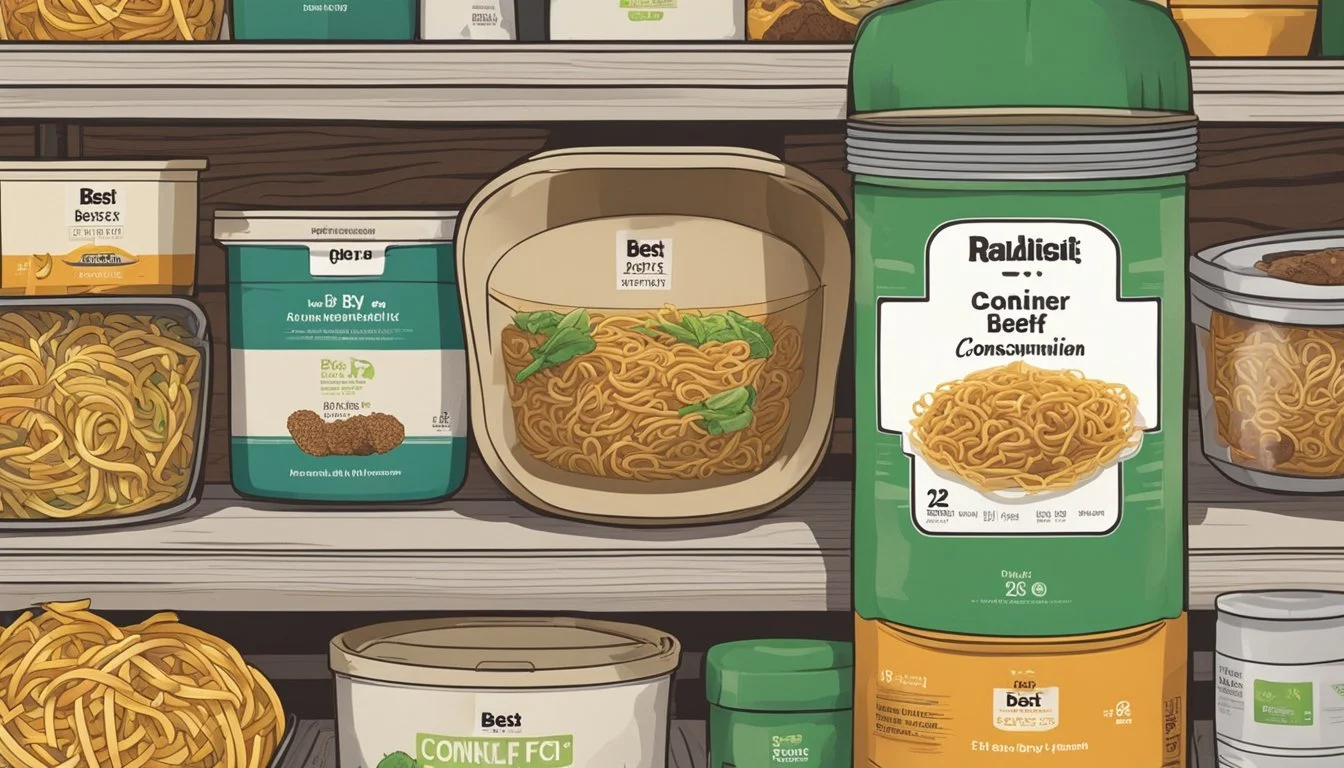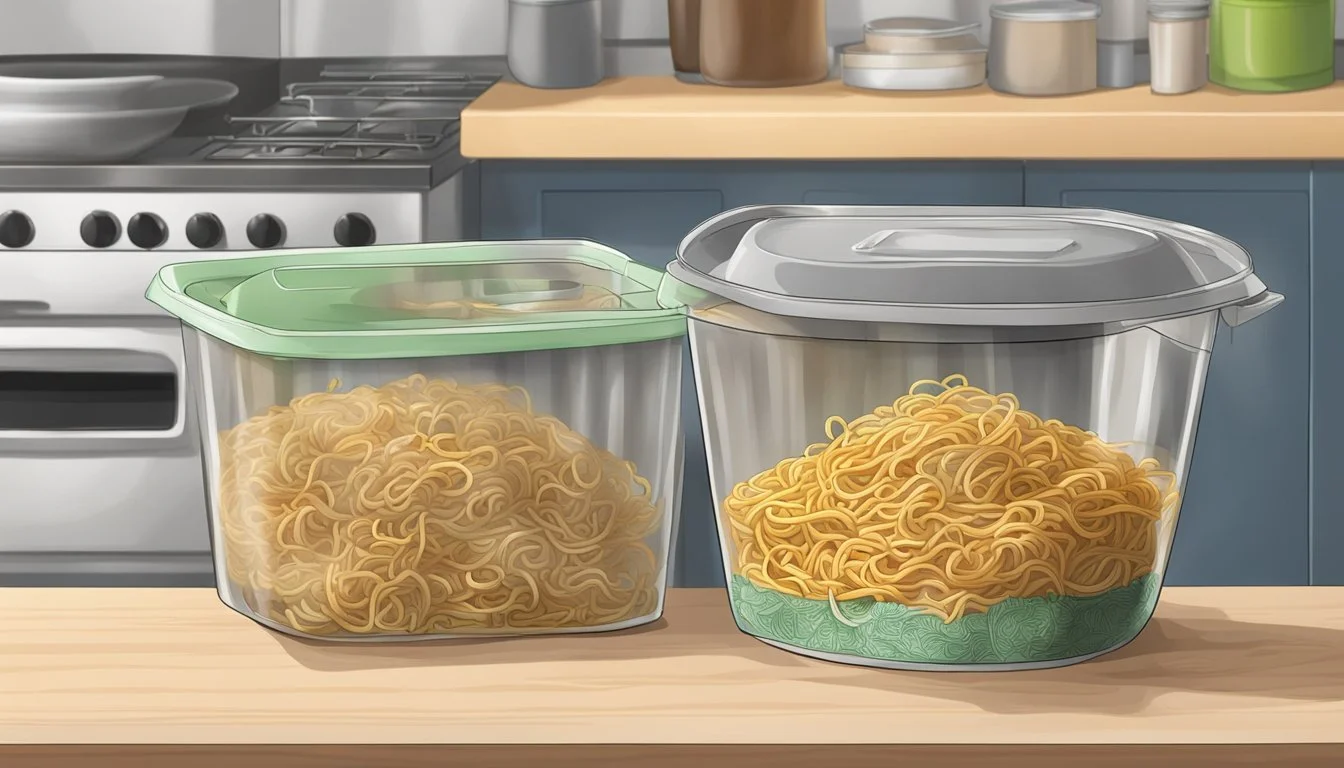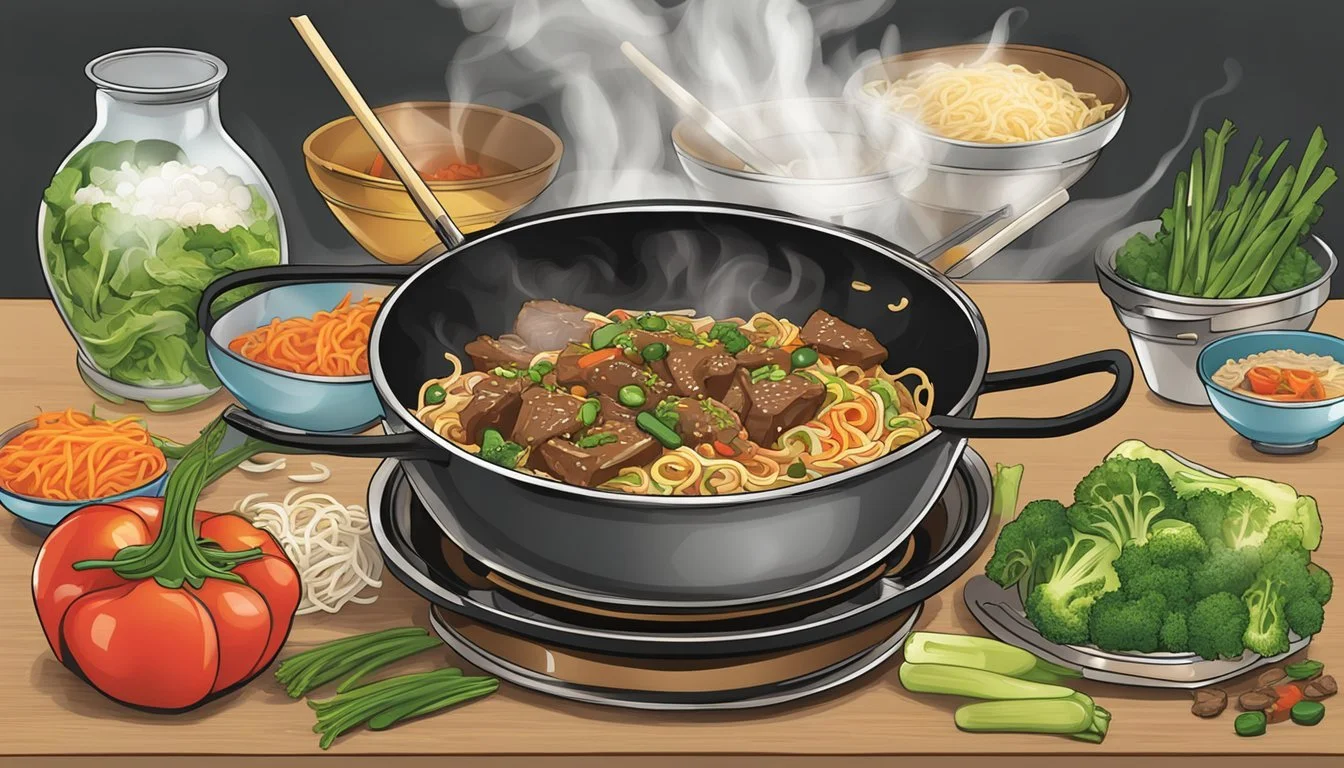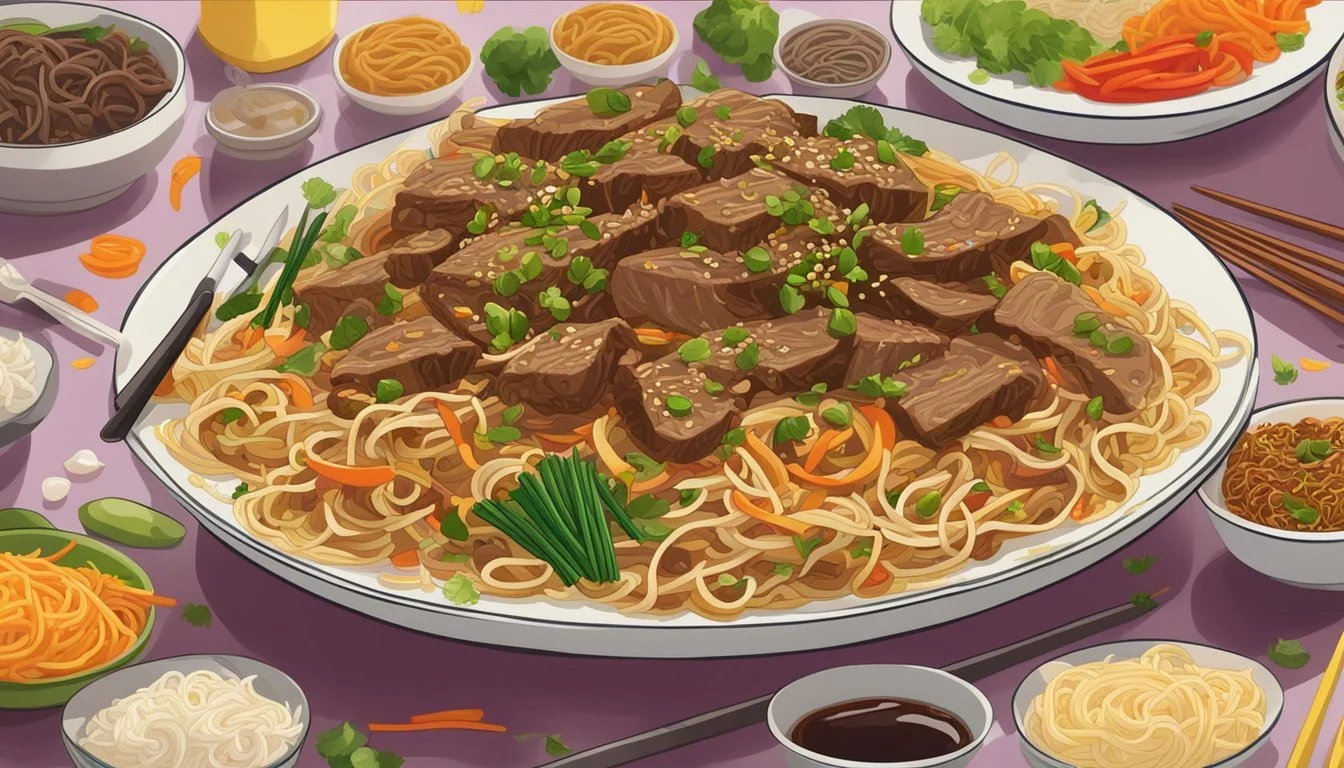How Long Does Beef Chow Mein Last?
A Guide to Storage and Freshness
Beef chow mein, a staple in Asian cuisine, is a beloved main course that often finds its way into our refrigerators as leftovers. Many savor its mix of tender beef, crisp vegetables, and aromatic sauces. Properly stored, leftover beef chow mein lasts for 3 to 4 days in the refrigerator, ensuring you can enjoy this Chinese food dish without worry for a few days.
Refrigeration isn't your only option, though. For those looking to extend the lifespan of their beef chow mein, freezing is a practical method. When stored correctly in airtight containers, frozen beef chow mein can maintain its quality for up to 2 months. This is particularly handy for meal prepping or if you're a fan of cooking in bulk.
Keeping food safety in mind is crucial to enjoy your meal without any health concerns. Always ensure your beef chow mein is kept in airtight containers and promptly stored at the right temperatures. This way, every bite of this delectable dish retains its flavor and freshness.
Understanding Beef Chow Mein
Beef chow mein is a popular Chinese dish known for its savory and umami flavors. This dish combines tender beef with vegetables and noodles, making it a balanced and flavorful meal.
Main Ingredients
Beef chow mein features key ingredients like beef, which is typically sirloin for its tenderness. Chinese egg noodles or chow mein noodles are used for their firm texture that holds up well during stir-frying. A variety of vegetables including carrots, green onions, and garlic add both flavor and nutritional value.
The sauce is an essential component, often made from soy sauce, oyster sauce, and a bit of sugar to balance the savory flavors. Oil is used for stir-frying, usually a neutral oil like sunflower or vegetable oil.
Typical Preparation
Beef chow mein preparation begins by slicing the beef sirloin into thin strips, ensuring it cooks quickly and remains tender. The meat is often marinated briefly with soy sauce and other seasonings.
Vegetables are chopped and set aside, with firmer vegetables like carrots added early in the cooking process. The noodles are usually pre-cooked and rinsed in cold water to stop the cooking process.
Cooking is done with a wok or large frying pan over high heat. The beef is seared first, then removed and set aside. Vegetables are stir-fried until they begin to soften. Finally, everything is combined—beef, vegetables, noodles, and sauce—stir-fried together for a few minutes to blend the flavors.
Storage Basics
Storing beef chow mein correctly is key to maintaining its flavor and ensuring food safety. Proper storage techniques involve both refrigeration and freezing, each with specific guidelines for optimal results.
Refrigeration Guidelines
Beef chow mein should be refrigerated within two hours of cooking to minimize bacterial growth. Airtight containers are essential to preserve the dish’s freshness and prevent contamination. When refrigerated, beef chow mein typically lasts 3 to 4 days.
Store chow mein at temperatures below 40°F (4°C). Ensure that the fridge is not overcrowded and air circulates freely around the container. Chow mein sauce and other ingredients must also be considered - ingredients with natural preservatives may last slightly longer, but it's best to adhere to the 3-4 day guideline.
Label airtight containers with the date of storage to keep track of their expiration dates. Before consuming, check for signs of spoilage, such as unpleasant odors or changes in texture.
Freezing Instructions
For longer storage, freezing beef chow mein is a practical option. Properly stored, frozen chow mein can last for up to 2 months. Freezer bags or airtight containers should be used to prevent freezer burn and moisture loss.
Before freezing, allow the chow mein to cool completely. Portion the leftovers into meal-sized servings to make defrosting easier. Squeeze out excess air from freezer bags before sealing.
Label each container or bag with the expiration date, noting when it was frozen. When ready to eat, thaw in the fridge overnight or use a microwave on the defrost setting. Reheat thoroughly to ensure food safety, as reheating to at least 165°F (74°C) is necessary to kill any potential bacteria.
Maximizing Shelf Life
Proper storage of beef chow mein is essential to ensure it remains safe to eat for as long as possible. Key factors include the type of container used and maintaining an optimal refrigerator temperature.
Suitable Containers
Using airtight containers is crucial for maximizing the shelf life of beef chow mein. These containers prevent air, moisture, and bacteria from contaminating the food. Glass or plastic containers with tight-fitting lids are ideal. Avoid using metal containers as they can react with the sauce and alter the flavor of the dish.
When storing leftovers, ensure the chow mein is completely cooled before sealing the container. This prevents condensation inside, which might promote bacterial growth. Portioning the chow mein into smaller servings can also help cool it faster and reduce the risk of contamination when reheating only what's needed.
Optimal Refrigerator Temperature
Refrigeration is key to extending the shelf life of beef chow mein. Store it at a temperature below 40°F (4°C). This temperature range slows down the growth of harmful bacteria. Using a fridge thermometer can help maintain this temperature consistently.
In addition to the appropriate temperature, it's important to place the chow mein in the coldest part of the fridge, usually at the back. Avoid storing it in the door where temperatures can fluctuate more. Make sure the fridge is not overcrowded to allow for proper air circulation. Maintaining these conditions can help keep the beef, noodles, vegetables, and sauce fresh for up to 3-4 days.
Reheating for Quality and Safety
Properly reheating beef chow mein ensures that it remains both safe to eat and retains its delicious flavors. Reheating methods include using a microwave for convenience or a stovetop for better texture and taste.
Microwave Reheating
Using a microwave to reheat beef chow mein is quick and easy. First, place the leftover chow mein in a microwave-safe dish. Add a tablespoon of water or broth to prevent the noodles from drying out. Cover the dish with a microwave-safe lid or plastic wrap, leaving a corner open for steam to escape.
Microwave the chow mein on medium power for 1-2 minutes. Stir the noodles halfway through to ensure even heating. Continue microwaving in 30-second intervals until the chow mein is heated thoroughly.
Note: Microwaves can heat unevenly, so always check that the dish is heated through to reduce the risk of food poisoning. Ensuring even heating is crucial for food safety.
Stovetop Reheating
Reheating beef chow mein on the stovetop enhances the dish’s texture. Begin by heating a wok or a non-stick skillet over medium heat. Add one to two tablespoons of vegetable oil or sesame oil. Once the oil is hot, add the leftover chow mein.
Stir-fry the noodles for 3-5 minutes, stirring occasionally to ensure even heating. Make sure to break up any clumps of noodles for a consistent temperature throughout.
Tip: Adding a small splash of water or broth can help keep the noodles moist. This method also helps to bring back the original stir-fried flavors and prevent the dish from becoming overly dry.
In both reheating methods, ensure the chow mein reaches a safe internal temperature to avoid any potential foodborne illness. Proper reheating not only maintains the dish's flavor but also ensures it is safe to consume.
Recognizing Spoilage
Identifying when leftover chow mein has gone bad is crucial for preventing food poisoning. There are several indicators that suggest spoilage, including changes in appearance and smell, and ensuring proper disposal is equally important for food safety.
Visual and Olfactory Indicators
Appearance: Spoiled beef chow mein often shows visible signs of deterioration. Look for mold or discoloration, which can appear as green, white, or black spots on the food. Additionally, a slimy texture on the noodles or beef can indicate bacterial growth.
Smell: An off-putting or sour odor is a strong indicator that the chow mein is no longer safe to consume. Fresh chow mein typically has a savory aroma, so any deviation from this, including a rotten or sulfuric smell, is a sign of spoilage.
Safety Measures to Discard Properly
If any signs of spoilage are detected, it’s crucial to discard the leftovers immediately. Use a sealed plastic bag to contain the spoiled chow mein before throwing it away to prevent contamination. Always wash hands thoroughly after handling spoiled food to avoid spreading bacteria.
Check the expiration date and follow recommended shelf life guidelines to minimize the risk of consuming spoiled leftovers. Beef chow mein typically lasts 3 to 4 days in the refrigerator and up to 2 months in the freezer when stored properly. Adhering to these guidelines can help ensure food safety.
Nutritional Considerations
Beef chow mein offers a balance of meat and vegetables, presenting a diverse nutritional profile. Consider the following aspects for a detailed understanding of its caloric content and macronutrient distribution.
Caloric Content
A standard serving of beef chow mein typically contains approximately 300-400 calories per serving. This number can vary based on specific ingredients and portion sizes.
The inclusion of oil for stir-frying and sauces like soy sauce and oyster sauce contribute to the total calorie count.
The use of egg noodles versus rice noodles can slightly affect caloric content, with egg noodles generally being higher in calories.
Pay attention to serving sizes when considering caloric intake, particularly if additional side dishes or meals are being consumed.
Macronutrients and Diet
Protein: Beef in chow mein offers a rich source of animal protein, while vegetables contribute some plant-based protein.
Carbohydrates: The noodles are primarily composed of wheat flour, making them high in carbohydrates. This could be an important factor for those monitoring their carb intake.
Fats: The oil used in cooking and any added proteins contribute to the fat content. While sunflower oil and similar oils provide unsaturated fats, beef adds saturated fats.
Vitamins and Minerals: Vegetables such as carrots, onions, and other mixed greens offer vital vitamins and minerals. Ginger and sesame oil not only add flavor but also health benefits, like anti-inflammatory properties.
Dietary Considerations: For those with dietary restrictions, there are options like rice noodles or adjustments in vegetable choices. Awareness of soy sauce's sodium content is crucial for those monitoring salt intake.
Culinary Tips and Tricks
Attention to flavor enhancement and preparation variations can elevate the beef chow mein experience. Achieving a balance of umami and perfect texture adds depth to the dish.
Enhancing Flavor
To boost umami, soy sauce and oyster sauce are key ingredients. Garlic and green onions should be added early to release their rich, aromatic oils. For an extra kick, a dash of chili can be included.
Marinating the beef in a mixture of soy sauce, a bit of sugar, and sesame oil for at least 10 minutes helps infuse the meat with flavor. Adding mushrooms provides a savory depth, while a touch of hoisin sauce adds a hint of sweetness.
Sesame oil should be used sparingly as a finishing touch to enhance its nutty profile. Consistent stirring during cooking ensures even distribution of sauces and spices.
Preparing Variations
Beef chow mein can be tailored to different tastes and dietary preferences. For a seafood twist, swap the beef with shrimp or a mix of seafood, adjusting the cooking time to prevent overcooking.
Chicken chow mein is another popular variation, where thinly sliced chicken breast or thighs are used instead of beef.
For vegetarians, a vegetable chow mein is a flavorful choice. Use a variety of colorful vegetables like bell peppers, carrots, and mushrooms. Adding tofu can provide protein while maintaining a lighter dish.
Using vegetable oil instead of animal fat can cater to a broader audience, making the dish suitable for more dietary restrictions. Each variation maintains the core elements that make chow mein a favorite while adapting to different preferences.
Understanding Chow Mein Varieties
Chow mein and lo mein are popular noodle dishes that offer distinct textures and flavors. The key differences between these dishes lie in the types of noodles used and the methods of cooking.
Chow Mein vs. Lo Mein
Chow mein typically uses thin egg noodles that are either parboiled or soaked before being stir-fried until crispy. This dish often features a variety of vegetables and proteins like beef, chicken, or shrimp, seasoned with soy sauce, garlic, and ginger.
Lo mein, on the other hand, uses soft, boiled egg noodles or fresh lo mein noodles. These noodles are not fried but rather tossed with a savory sauce and cooked ingredients. The sauce, usually made from soy sauce, oyster sauce, and sesame oil, coats the noodles, giving them a rich flavor.
Chow mein offers a crunchy texture due to the frying process. In contrast, lo mein provides a chewy and soft consistency.
Regional Differences
Chow mein varies significantly based on regional preferences. In the United States, American-Chinese chow mein often includes crispy noodles served with a thick, starchy sauce. The East Coast version might have a softer consistency, while the West Coast version is usually crispier.
In China, Cantonese-style chow mein features fried noodles topped with fresh vegetables and meats, often served separately to retain the noodles' crispiness. Sichuan chow mein relies heavily on spicy and bold flavors, incorporating ingredients like chili oil and Sichuan peppercorns.
In Hong Kong-style chow mein, the noodles are fried to a crisp and served with a light sauce, focusing on a balance of textures. The regional culinary practices significantly influence the choice of noodles, whether it's thin egg noodles, wheat flour noodles, or uncooked Chinese noodles.
These variations ensure that chow mein can appeal to a wide range of tastes and preferences, demonstrating its versatility as a beloved dish.
Food Pairing and Serving Suggestions
Beef chow mein, a staple in Chinese takeout, pairs well with a variety of complementary dishes and side options. This makes it a versatile and satisfying main course that can fit into diverse meal settings.
Complementary Dishes
For those seeking to elevate their beef chow mein experience, consider Cali Style Instant Pot Teriyaki Chicken. This dish requires chicken thighs and few pantry staples, making it a simple yet delicious addition. Cooked in approximately 20 minutes, this teriyaki chicken adds a sweet and savory contrast to the savory notes of chow mein.
Spring rolls also complement beef chow mein well. These crispy, vegetable-stuffed rolls add both texture and a freshness that balances well with the noodles and beef. Serve them with a sweet chili sauce to further enhance their flavor.
Hot and sour soup is another great pairing. The tangy, spicy flavors of this soup provide a brilliant counterpoint to the rich taste of beef chow mein. This classic Chinese soup is usually made with tofu, bamboo shoots, mushrooms, and occasionally shredded pork, providing additional protein and vegetables to the meal.
Appropriate Side Options
Optimal side options for beef chow mein include different vegetables and light, palate-cleansing selections. One such side is steamed broccoli. Lightly seasoned with a touch of soy sauce or oyster sauce, the broccoli retains its crunch and brings a fresh taste to the table.
Egg rolls also stand out as a strong side option. Filled with a blend of cabbage, carrots, and minced meat, they offer a satisfying crunch and robust flavor profile. Pairing them with a hoisin or plum sauce enhances the taste experience.
An additional recommendation is stir-fried green beans. Cooked in vegetable oil with garlic and soy sauce, these beans offer a crisp texture and savory taste, harmonizing well with the flavors of beef chow mein.
For a lighter touch, a cucumber salad dressed in rice vinegar, sesame oil, and a sprinkle of chili flakes can be refreshing and cleansing, balancing the dense flavors of the main dish.

